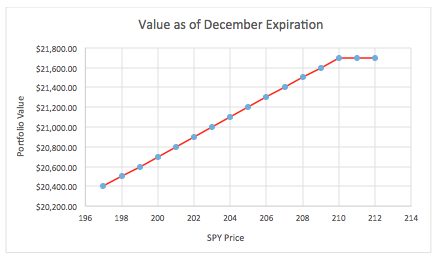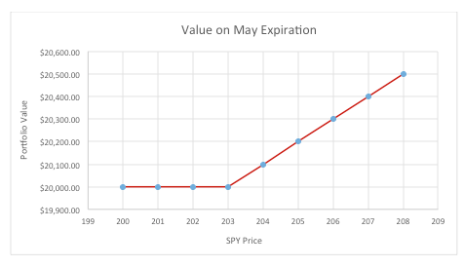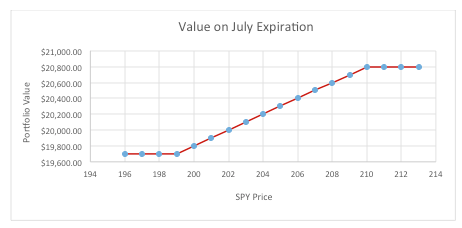Using Options to Hedge a Portfolio
A few Cabot Options Trader subscribers have asked me about ways to protect gains in their portfolios, so I thought I would write to everyone with a couple of strategies using options to hedge your portfolio.
Because I can’t possibly know what you have in your portfolio, I’ll base the strategies on the SPDR S&P 500 ETF (SPY), which corresponds to the price and yield performance of the S&P 500 Index.
(Note: You may not be allowed to hedge your mutual fund holdings by trading the SPY. For instance, if you own mutual fund XYZ, your broker may not allow you to sell calls in the SPY because they don’t move in exact correlation. But that is a conversation you should have with your brokerage provider.)
The SPY is trading at 204 this morning. For this exercise, I’m going to assume that you own 100 shares of SPY, which is currently worth $20,400.
Here are a couple different strategies you can use to “hedge” your portfolio.
Covered Call
A covered call is a risk-reducing strategy; in this, a call option is written (sold) against an existing stock position on a share-for-share basis. The call is said to be “covered” by the underlying stock, which could be delivered if the call option is exercised.
This is a great way to create yield in your portfolio, though I will say it does not “hedge” you entirely. If the SPY were to drop dramatically, you would collect the premium taken in, but you would still be long the stock.
So based on our example, you own 100 shares of the SPY, and therefore you are able to sell 10 calls against your stock so that you are covered.
For this theoretical exercise, I will look seven months out, and 3% out-of-the-money. Based on this criteria, you could sell December 210 Calls for $7.00. If the SPY stays below 210 by December expiration, you would collect $700, or a yield of 3.43%. If you do that twice a year, you would collect $1,400—a yield of 6.86%.
You can choose any number of months or strikes. For instance, you can sell one December 210 Call or one January 215 Call. There are nearly limitless amounts of calls you can sell in many different combinations.
This is a profit and loss graph of your covered call position:
Put Option Purchase
Again assuming you own 100 shares of the SPY, the truest hedge would be to buy one put against it. If the SPY drops below your put’s strike price, you could simply exercise your put, and you would be out of your entire stock position. The upside to this strategy is that you do not cap the potential profit if the SPY price continues to rise.
For instance, you could buy one May 203 Put for $3.00. So if the SPY dropped below 203, you would exercise your put and be taken out of your SPY stock position. However, you have to pay $3.00 ($300 for 1 put) for this insurance. But with the VIX at historically low levels, this insurance is extremely cheap based on historical prices.
Again, you can choose any number of strikes and timeframes for this strategy.
This is a profit and loss graph of your put purchase position:
Risk Reversal
This is a more sophisticated strategy, but a truer hedge to your portfolio than a covered call. You must be able to trade spreads in order to execute a risk reversal.
In this example, you will sell a call that is out-of-the-money and buy a put that is out-of-the-money. This strategy will reduce the capital that you have to pay for your hedge but it limits your upside.
Once again, assuming you own 100 shares of the SPY, you could sell July 210 Calls for $3.00 and buy July 198 Puts for $5.00. In this case, your capital outlay is only $200, whereas in the put purchase above, you paid $300.
Let’s break down the various scenarios of this trade. If the SPY were to go below 198, you could exercise your puts and get out of your stock position. On the other hand, if the SPY were to rally above 210, you would be taken out of your stock position by the holder of your short call. If the SPY were to stay between 198 and 210, the options positions would expire worthless and you would be out the $200 that you paid for this position.
This is a profit and loss graph of your risk reversal position:
Conclusion
You can use any of these option strategies against any of your equity or index holdings. If you own a lot of Boeing (BA) or General Electric (GE) stock for instance, you can hedge your stock positions with these option strategies.
If you want to hedge your mutual fund holdings, talk to your brokerage provider to see how you can implement strategies like these.
Your guide to successful options trading,
Jacob Mintz
Analyst and Editor, Cabot Options Trader


